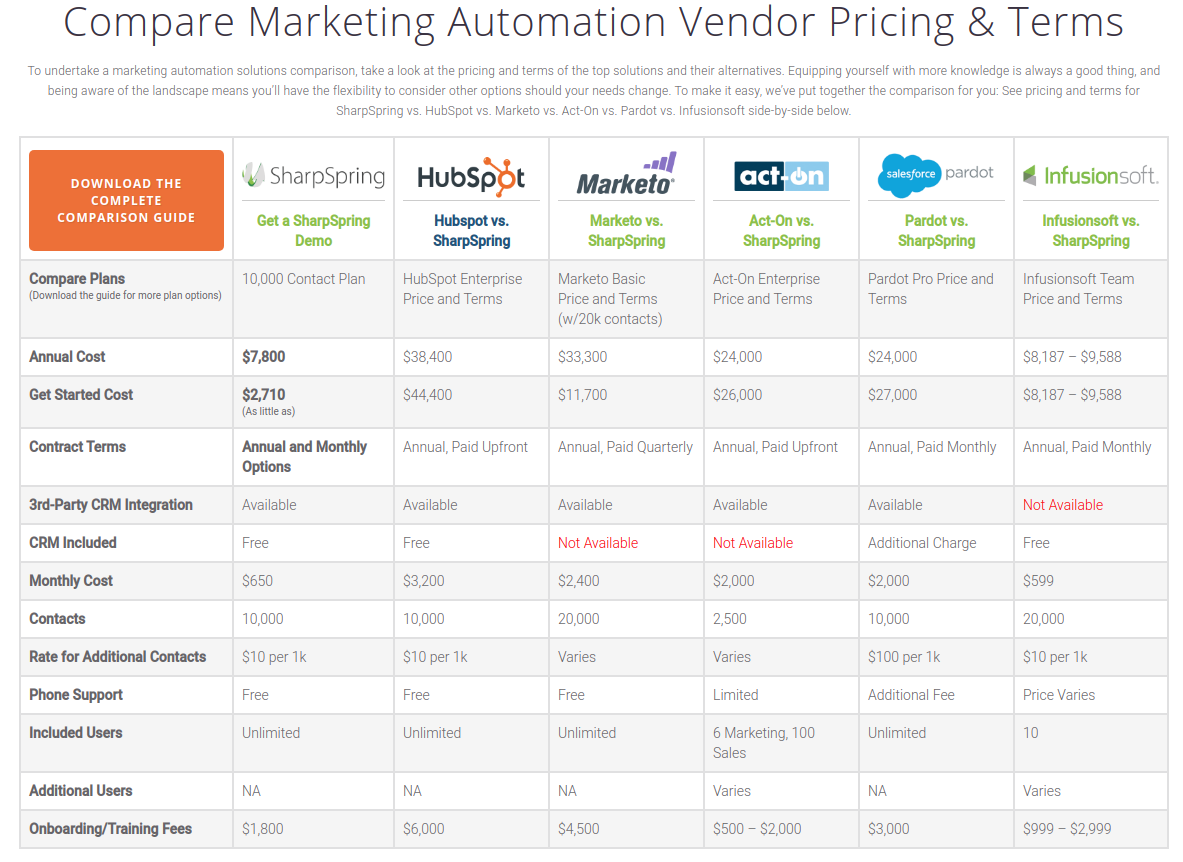Technology
Patreon Assembly going on now!
https://www.patreon.com/9malls
Join the fun:
http://patreonassembly.com/
Great line up:
WHITNEY CUMMINGS
ISSA RAE
LOCAL NATIVES
WHITNEY CUMMINGS
PATTON OSWALT
KILLER MIKE
GABBIE HANNA
JACK CONTE
HANNAH HART
PAUL SCHEER
SCOUT TAFOYA
ERICA CAMPBELL
MARIA MENOUNOS
We are excited to announce a new store just added to 9malls. They are called Sharpspring. It’s a top ranked marketing automation company. For a live demo visit Sharpspring directly.
What is marketing automation?
Marketing automation refers to software platforms that help businesses automate their marketing and sales engagement processes to generate more leads, convert those leads to sales and optimize ROI. Marketing automation allows businesses to automate repetitive tasks such as sending emails, maintaining social media, tracking website interactions and handling various other tasks. Marketing automation centralizes all of the features and functions that make up the marketer’s role in an organization.
A marketing automation platform should have the ability to integrate with other sales and marketing tools (CMS, CRM, social media, meeting software and more) to provide a streamlined platform for data management and analysis.
What Does Marketing Automation Software Do?
- Drive More Leads
- Convert Those Leads into Sales
- Maximize Marketing Spend.
See Comparison Graphic
SharpSpring Feature List
Email – Put an end to boring, mass email blasts and save time on your marketing strategy. Start conversations that lead to conversions with personalized messages and automated campaigns that respond to user behavior. Use the SharpSpring email marketing platform to track leads “after the click.” Unlike other email service providers, we offer detailed analytics on every interaction – so you can send the right message at the right time, and send your sales team into action with real-time notifications.
Forms – Build, customize and reorder fields effortlessly with the sleek drag-and-drop editor. Our dynamic forms autocomplete fields for known visitors to improve conversion and look great on any site with custom CSS. You can even map fields from 3rd-party and native forms.
Automation – Our powerful, easy-to-use visual workflow builder simplifies marketing automation. Use branching logic to engage leads at critical points in their unique buying journeys. Instantaneously sync information with our built-in marketing automation CRM suite. Set up buyer personas for your products and services, then assign leads to different personas so that you can send automatically targeted messages. Receive a list of each day’s hottest leads right to your inbox, and act at just the right time to convert them to sales. Use SharpSpring’s marketing automation tools to score leads based on engagement, page tracking, fit and more – they even factor in natural lead decay over time.
Visitor ID – VisitorID is one of the secret weapons in our stack of marketing automation tools. Use it to identify twice as many visitors to your site (compared to competing marketing platforms). Use behavioral-based tracking to truly understand what motivates each click. Identify pain points and successful strategies so that your website never stops optimizing. Receive a list of the day’s hottest leads directly to your inbox, and act at just the right time to convert those leads to sales.
CRM – Knowledge is power – and CRM is sales. Use our marketing automation CRM or seamlessly integrate your preferred CRM provider with the SharpSpring marketing platform. Keep integrated data up to speed with instant two-way synchronization. Track opportunities from creation to close with a bird’s eye view of your pipeline. Create custom deal stages, fields, filters and more, to manage sales effortlessly with our marketing automation tools.
Landing Pages – Build powerful landing pages and landing page funnels that transform visitors into leads. Use our simple point-and-click editor to create unique landing pages, or adapt a template from our extensive library. Set up chains of linked landing pages to organize visitors into different funnels. Drive more conversions with dynamic web content that changes based on visitors’ interests and attributes. Deliver results quickly without coding or a developer, and without touching your website – but for those who want total control, you can add your own HTML and CSS code to customize pages even further.
Blogs – Launch a blog in minutes with the blog builder and editor in our marketing automation system. Design, manage and publish posts with ease. Set up collaborations within your team, or create profiles to welcome guest bloggers. Extend the reach of your content with RSS email syndication that automatically sends new posts to your mailing lists. Get more reach out of your content with social media widgets that allow users to share and follow you online. Use SharpSpring’s marketing automation tools to track visitors, find out which content performs best, and target posts to maximize conversions.
Marketing Analytics – Make key decisions with accurate and relevant data. Choose the most important metrics for each campaign and message, then generate custom reports to review your performance. Understand end-to-end ROI and track lead sources – even from offline. Share key information with your team, clients, and customers in a readable and accessible display.
Platform – Connect to hundreds of third-party software providers with SharpSpring’s APIs and Zapier integration. Sync data with your marketing automation CRM systems, keep your content management systems updated and integrate native and third party web forms with our marketing platform. Truly make SharpSpring your own by rebranding emails, notifications, reports, and even the app itself. Store data on our encrypted, secure, and scalable platform.
Social – Go beyond publishing, scheduling, and monitoring. Turn social interactions into meaningful conversations that generate sales and show up in your marketing reports. SharpSpring Social offers all the features you expect from a social management solution, plus powerful conversion tools you can only get from a fully-integrated marketing platform. Trigger automated workflows and score social leads based on interactions, sources, interests and more. Measure end-to-end ROI of integrated marketing campaigns and demonstrate the value of your social media efforts.
When Sling TV was launched back in February, it showed exciting promise for those who wanted instant access to live TV without the cost and without a contract. It looked like the new DISH service would be a winner. Well, the stats are now in and our expectations have not disappointed us.
By the end of its very first month, it was announced that Sling TV had already signed up 100,000 customers. Now, according to a new report dated June 5, the number of subscribers has more than doubled to 250,000.
Is It Just the Newness of Sling TV or Is It Really That Special?
Well, the answer is both. To be sure whenever something that is in demand (live TV), is easily accessible without special equipment, and cuts out-of-pocket expenses (Sling TV basic is only $20 a month), people will tend to try it. So there you have a major asset to a Sling TV subscription. But, at present the lineup for Sling TV programming is still somewhat limited. For the basic $20 a month you will receive access to only about 40 channels. There are currently 7 add-on packages available for an additional $5 apiece however. As time goes on, Sling TV is planning to add more options (at additional costs of course).
The Connectivity of Sling TV
One of the things that attracted people to cable in the first place was the speed and quality of the connectivity. So far the final ruling is out as far as connectivity is concerned with Sling TV.
According to a review by Nick Pino on Techradar.com:
“Depending on your connection speed, Sling TV is either a dream or a nightmare.”
He has done tests watching Sling TV on various devices. Here are his comments on his viewing experience using an iPhone:
“Using an iPhone 5S for testing, I took Sling TV with me for a gauntlet of daily errands. As you might expect, over LTE the stream was nearly flawless. Dropping down to 3G, however, presented real problems as seconds slipped away to buffering screens.”
He did mention that one thing that will probably keep many subscribers connected to Sling TV:
“Being able to take TV figuratively anywhere is an appealing, practical proposition for morning commuters or long-distance travelers.”
Although Sling TV is a US-only service, it does seem that you can watch Sling TV anywhere in the world, but you must be able to “establish and maintain a bitrate of about 1.5 Mbps for high-quality streams, 0.8Mbps for medium resolution, and 0.5 Mbps for low-quality.”
Also, Sling TV won’t allow more than one device to run on the same account at the same time. As technology advances and Sling TV adds more options, you can expect more customers signing up with DISH Sling TV. It is a technological advance that is here to stay!
Does it seem unthinkable to you that robots might be doing your job in a few years? Perhaps you are already in an industry where you have seen automated technology take over jobs that used to offer lifelong job security; but, robots, doing your job?
The truth is that things change so fast these days that before you know it there is a new set of rules. Not so long ago if you had a job that you did well you felt that you were set for life. Most people stayed in jobs for years and could count on retiring with a pension that could support them in their old age, not so today.
The History and Present Use of Robots as They Relate to Your Job
The Australian Roboticist, Rodney Brooks, has stated:
“Over the next twenty years no one is going to mistake a robot for a person, but nevertheless, we will interact and collaborate with robots and they will become as common place in our lives as turning to a search engine is today.”
The truth is that since 1954 robots were beginning to replace workers in industrial jobs. While this may seem like a red flag for the workers whose jobs were replaced by robots, it was actually a benefit to them. Most of the jobs that are now done by robots were and are accompanied by significant health and safety risks.
The jobs that are currently done by robots in the industrial industry are:
Welding
Assembly
Picking and Packing
Contamination clean-up in sealed and insulated environments
Industries that currently heavily use robots are:
Electronic
Optical
Aerospace
Automotive
Food
Textile
Tooling
In addition, over the last 30 years or so software and robots have been replacing the work that used to be done by middle-skilled, average-wage workers; the kind of routine jobs that were done in manufacturing and office administration.
As technology continues to advance at a rapid rate we are already seeing how the military is benefiting from robots. The three most important areas where robots are being used in the military at present are:
Aerial (Drones and Surveillance)
Explosive Ordinance Disposal (EOD)
Search-and-Rescue
The Projected Future of Robots
Several industries that are making plans for using robots in the future as technology advances are:
Agriculture (Caterpillar is developing heavy robotic machinery and already uses remote-controlled robots to operate their cranes.)
Medical (Robotic surgery assistants are already in use, and hospitals are planning extensive use of robots in the future.)
Elderly Domestic Care (As costs rise as well as the needs of the elderly, scientists are looking to robotic technology to fill the need)
Household Domestic Care (Bill Gates believes that by 2025 we could have robots in every home. Those domestic robots would range from vacuum cleaners that hide under a chair until needed to mechanical maids.)
So the question is will robots steal your job in the future? It really all depends on you. If you are open-minded and willing to learn and grow with the technology, the answer is no. If on the other hand, you resist change and aren’t willing to adjust, yes. Certainly jobs will change as more and more jobs are taken over by robots, but if we have learned anything from the past it is that different kinds of jobs become available. Robots and robotics are here to stay. We might as well enjoy them.
It’s official. After being eagerly awaited Sling TV is being launched to the general public.
What Is Sling TV?
The Dish Network Sling TV is a Net-delivered video service. Net TV can be watched on computers, tablets and smartphones. It can also be viewed on TVs with the proper attachments. Glenn Hower, research analyst with Parks Associates, has stated:
“The percentage of subscribers interested in (Net-delivered, over-the-top) video services is trending upward, and more industry players are planning to launch their own OTT services. The age of appointment television is coming to a close, and programming will need to adapt to an on-demand environment.”
Later this year, HBO plans to launch a standalone Net service. Research has shown that of the roughly 91% broadband homes that are also pay TV customers, about half would cancel pay TV once they can get the new HBO service.
With the Sling TV launch, it puts Dish Network on the ground floor of this new trend.
How Does Sling TV Work?
According to Mike Snider of USA Today, who was one of the early testers of Sling TV:
“Sling TV is easy to use. For starters, you need a robust broadband internet connection — Netflix recommends 5 megabits per second for HD quality.”
“You download the Sling TV app onto your device whether it’s an Android or iOS tablet or a Net TV device such as an Amazon Fire or Roku device connected to your TV or Xbox One video game system. Some smart TVs from LG and Samsung also will have the app.”
Once the initial connection is made, you can be up and running is minutes.
Pay TV versus Sling TV
The reason for creating Sling TV was to attract people who had dropped their cable and satellite connections, or never had pay TV connections.
According to Sling TV CEO, Roger Lynch, the new Sling TV has been designed to target Millennials. The Dish Network says that they are less likely to subscribe to pay TV, and they are the demographic group that is more technology savvy. But, David Lieberman, the executive editor of Deadline.com questions whether Sling TV will actually appeal to the Millennials. He feels that Sling TV, due to their current programming lineup, may actually “appeal more to cash-strapped cable and satellite subscribers than it will to young adults.”
Initially, the Sling TV programming packages don’t come close to comparing with pay TV packages, but there are plans to expand the different offerings. At this time of launch, the Base Package, which costs $20 a month, with no contract like pay TV, gives you live feeds to ESPN, ESPN2, TNT, TBS, Food Network, HGTV, Travel Channel, Adult Swim, Cartoon Network, Disney Channel, ABC Family and CNN. A Kid’s Package and a News Package are also offered for an additional $5 each. There lineups are also very limited at this time. Plans for future expansion will add a Sports Package, but for now subscribers will be happy to be able to get live feeds on ESPN, ESPN2 and CNN. Getting live feeds is a big advantage for Sling TV. Up until now, the only way to get live sports was by having pay TV connection.
How to Get the New Sling TV
In an article that was posted on January 26th online at USA Today entitled, Sling TV looks to liven up streaming video party, Mike Snider wrote:
“The Internet-delivered subscription video service from satellite TV provider Dish Network will begin official operations Tuesday (January 27). The first invites start going out at 12 a.m. ET Tuesday to customers who preregistered on Sling.com.”
“Everyone else has to wait, but they will get a free one-week trial when the service opens to all customers within the next two weeks. Consumers who don’t have one of the supported Net TV devices such as an Amazon fire or Roku device can sign up on Sling.com to order a device as part of a subscription package (prices to be announced).”
Remember, it’s only $20 a month with no contract to try it out.
The world of marketing and commerce has been going through some major transformations in the past decade, with online shopping slowly replacing brick and mortar stores for many people. With smartphones and other mobile options, the dream of many online marketers is to move to a completely digital world for shopping, but in reality, what we see is a mix of the two. People use their smartphones to find things out about real world stores, things like being able to compare prices on the fly, scanning bar codes, or even redeeming online coupons right there at the cashier. Now, Nielsen, the biggest stats company out there, has released some hard numbers on what customers have been doing with their smartphones while shopping in actual stores.
The numbers and trends are interesting, if not a bit obvious. For a start, most people use coupons at grocery stores. 41% of customers who used mobile coupons, meaning they had a smartphone app or some type of phone based coupon to show at the cashier, did so at a grocery store. 41% did this at a department store, 39% at clothing stores, and 29% at electronic stores. These numbers may be skewed however because they depend a lot on what coupons are available, and typically groceries have always had a biggest presence in coupons. But this is clearly changing, with other types of shops starting to become prime target for coupon using mobile customers.
When it comes to reading reviews, trends seem even more clear. 73% of those who use a smartphone while shopping have read reviews while inside such a store. For department stores, that figure goes to 43%, then 34% for mass merchandisers. But some people take things a bit further, and go scanning QR or bar codes. Any recent smartphone now has the ability to take phones, and apps are available to scan and identify these bar codes. From there, you can know not only the name of the product you just scanned, but also whether there’s better prices available online or at local competitors. 57% of smartphone owners did just that at electronic stores, 36% at department stores, and 31% at mass merchandisers. These apps are often so quick and easy to use that while you’re standing in front of a product, it takes just seconds to know right away if a store down the street has the same item, at half price.
So in the end, it’s not really surprising to see smartphone users use their devices for more than just keeping a shopping list. With all the apps available, it proves that technology isn’t only used online, but it can help a lot while shopping on your own two feet. By getting instant coupons, checking reviews, or scanning bar codes, you can be sure to only get the items you want, at a price that’s competitive.



